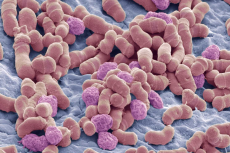

GCSE BIOLOGY REVISION: INFECTION AND RESPONSE
Please note: Text in bold is what the AQA GCSE biology specification requires an understanding of.
Fungal disease
Rose black spot is a fungal disease where purple or black spots develop on leaves, which often turn yellow and drop early. It affects the growth of the plant as photosynthesis is reduced. It is spread in the environment by water or wind. Rose black spot can be treated by using fungicides and/or removing and destroying the affected leaves.
Just like with bacteria, not all fungi cause disease. Yeast, for example, is a single-celled fungus that holds significant economic importance as it is used for the production of bread and beer. Some fungi can be multicellular however, like mushrooms. Fungal cells are eukaryotic and therefore have a nucleus.
Athlete’s foot
This fungal infection leads to a rash found in people’s toes. Symptoms consist of dry, red and flaky or white, wet and cracked skin. This infection is often found in swimming pool changing rooms, gyms and other communal areas. Transmission happens when infected skin touches other skin or surfaces. This is why someone who has athletes foot should not share a towel with someone else. It can be treated by antifungal medication.
Rose black spot
Rose black spot is caused by a fungus which infects roses. Leaves become blotchy with black or purple spots. The remaining leaves turn yellow and often fall off of the plant. This inhibits that plants ability to photosynthesise, thus, growth is reduced. Rose black spot can be transmitted in the air or in water, as well as through direct contact in gardening. Fungicides can be used to treat infected plants, removing plants and destroying them is effective too.
Human defence systems
Students should be able to describe the non-specific defence systems of the human body against pathogens, including the:
• skin
• nose
• trachea and bronchi
• stomach.
Students should be able to explain the role of the immune system in the defence against disease.
If a pathogen enters the body the immune system tries to destroy the pathogen.
White blood cells help to defend against pathogens by:
• phagocytosis
• antibody production
• antitoxin production
Luckily, our bodies have various non-specific defence systems that protect us against pathogens. This is called the first line of defence. They are non-specific because they work the same against all pathogens and do not require certain recognition sequences. Defence systems can be physical or chemical barriers.
The skin
The skin is highly effective as it covers almost all of our bodies. The skin acts as a barrier to pathogens, if it is cut, it instantly starts to heal itself. When a scab forms, pathogens cannot enter the body.
The nose
Ever seen people try and remove their nose hairs as it is seen as ‘unattractive?’ Well do not follow by their example as we actually need our nose hairs, they act as a physical barrier against infection. Additionally, our cells in the nose can produce mucus which can trap pathogens. The trapped pathogens then cannot enter the lungs. Blowing our noses removes the mucus and thus any pathogens inside the mucus are expelled.
image- https://www.thoughtco.com/types-of-pathogens-4135656

0 Comment:
Be the first one to comment on this article.